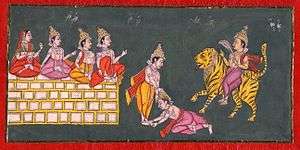Nivruttinath
Nivruttinath (c. 1273 – 1297) was a 13th-century Marathi Bhakti saint, poet, philosopher and yogi of the Vaishnava Nath tradition. He was the elder brother and the mentor (guru) of Dnyaneshwar, the first Varkari saint.[1][2]
Nivruttinath | |
|---|---|
| Personal | |
| Born | 1273 Apegaon, Aurangabad, Maharashtra, India |
| Died | Sanjeevan Samadhi Trimbakeshwar |
| Religion | Hinduism |
| Known for | Guru of Saint Dnyaneshwar |
| Order | Vaishnavism, Nath |
| Philosophy | Adwaita, Varkari, Hinduism |
| Religious career | |
| Guru | Gahaninath (NathPhilosophy) |
Disciples
| |
| Honors | Sant (Saint) |
| Part of a series on | |
| Hindu philosophy | |
|---|---|
 | |
| Orthodox | |
|
|
|
| Heterodox | |
|
|
|
|
|
|
Family and early life
Nivruttinath was born in Apegaon village on the bank of Godavari river near Paithan in Maharashtra into a Deshastha Brahmin family during the reign of the Yadava King Ramadevarava.[3][4]
Nivruttinath was one of the four children, and the eldest son, of Vitthalapant, a kulkarni (hereditary accountant), and Rakhumabai.[5]
Vitthalapant and his wife gave up their lives, within a year of each other by jumping into the Ganges,[6] leaving two sons, Dnyaneshwar and Sopan, and a daughter, Muktabai,[7] to be taken care of by Nivruttinath.
Nath Tradition
At around the age of 10, Nivruttinath's family moved to Nashik. During a pilgrimage trip, Vitthalapant along with his family was confronted by a tiger. The family escaped while Nivruttinath got separated from the family. He hid in a cave on the Anjani mountain where he met Gahaninath, who initiated Nivruttinath into the wisdom of the Nath tradition.[6][8][9]
Dnyaneshwar as disciple

The Natha Tradition is an initiatory Guru–shishya tradition. After the death of their parents, [8] Nivruttinath initiated Dnyaneshwar into the Nath tradition and become his teacher (Guru).[10]
Nivruttinath advised Dnyaneshwar to write an independent philosophical work. This work later came to be known as Amrutanubhav.[11][12][13]
Death and Resting Place
After the Samadhi of Dnyaneshwar, Nivruttinath left Alandi with his sister, Muktabai for a pilgrimage. During a thunderstorm, Muktabai was lost. Nivruttinath then attained Samadhi. The Resting place is situated near Trimbakeshwar. At his resting place, a temple has been erected which is visited by numerous devotees.
References
- Belsare, Kishori Devendra (983). Sant Nivruttinath _ a critical study.
- Mysticism in India: The Poet-Saints of Maharashtra. State University of New York. 1983. p. 31. ISBN 9781438416861.
- Bahirat 2006, p. 1.
- Karhadkar, K. S. (1976) [January–February 1976]. "Dnyaneshwar and Marathi Literature". Indian Literature. Sahitya Akademi. 19 (1): 90–95. JSTOR 24157251.
- Attwood 1992, p. 333.
- Bahirat 2006, p. 13.
- Sundararajan & Mukerji 2003, p. 33.
- Ranade 1933, p. 33.
- "From Nivrutti to Nivruttinath". www.speakingtree.in. Retrieved 11 August 2017.
- Bahirat 2006, p. 6.
- Abdi, Rupa. "THE WARKARI MOVEMENT I: Sant Dnyaneshwar – Beyond Brahmanical Tyranny". Retrieved 12 August 2017. Cite journal requires
|journal=(help) - Bahirat 2006, p. 14.
- Ranade 1933, p. 34.
Bibliography
- Attwood, Donald W. (1992), Raising cane: the political economy of sugar in western India, Westview Press, ISBN 978-0-8133-1287-3
- Bahirat, B. P. (2006), The Saint heritage of India, Cosmo Publications, ISBN 978-81-307-0124-0
- Ranade, Ramchandra Dattatraya (1933), Mysticism in India: The Poet-Saints of Maharashtra, SUNY Press, ISBN 978-0-87395-669-7
- Sundararajan, K. R.; Mukerji, Bithika (2003), Hindu Spirituality: Postclassical and Modern, Motilal Banarsidass, ISBN 978-81-208-1937-5